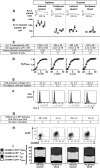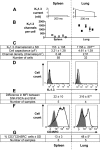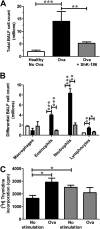Blocking KV1.3 channels inhibits Th2 lymphocyte function and treats a rat model of asthma
- PMID: 24644290
- PMCID: PMC4007452
- DOI: 10.1074/jbc.M113.517037
Blocking KV1.3 channels inhibits Th2 lymphocyte function and treats a rat model of asthma
Abstract
Allergic asthma is a chronic inflammatory disease of the airways. Of the different lower airway-infiltrating immune cells that participate in asthma, T lymphocytes that produce Th2 cytokines play important roles in pathogenesis. These T cells are mainly fully differentiated CCR7(-) effector memory T (TEM) cells. Targeting TEM cells without affecting CCR7(+) naïve and central memory (TCM) cells has the potential of treating TEM-mediated diseases, such as asthma, without inducing generalized immunosuppression. The voltage-gated KV1.3 potassium channel is a target for preferential inhibition of TEM cells. Here, we investigated the effects of ShK-186, a selective KV1.3 channel blocker, for the treatment of asthma. A significant proportion of T lymphocytes in the lower airways of subjects with asthma expressed high levels of KV1.3 channels. ShK-186 inhibited the allergen-induced activation of peripheral blood T cells from those subjects. Immunization of F344 rats against ovalbumin followed by intranasal challenges with ovalbumin induced airway hyper-reactivity, which was reduced by the administration of ShK-186. ShK-186 also reduced total immune infiltrates in the bronchoalveolar lavage and number of infiltrating lymphocytes, eosinophils, and neutrophils assessed by differential counts. Rats with the ovalbumin-induced model of asthma had elevated levels of the Th2 cytokines IL-4, IL-5, and IL-13 measured by ELISA in their bronchoalveolar lavage fluids. ShK-186 administration reduced levels of IL-4 and IL-5 and induced an increase in the production of IL-10. Finally, ShK-186 inhibited the proliferation of lung-infiltrating ovalbumin-specific T cells. Our results suggest that KV1.3 channels represent effective targets for the treatment of allergic asthma.
Keywords: Airway Inflammation; Allergy; Animal Models; Asthma; Cellular Immune Response; KCNA3; KV1.3; Potassium Channels; T Lymphocyte; Therapy.
Figures







References
-
- Bousquet J., Jeffery P. K., Busse W. W., Johnson M., Vignola A. M. (2000) Asthma. From bronchoconstriction to airways inflammation and remodeling. Am. J. Respir. Crit. Care Med. 161, 1720–1745 - PubMed
-
- Barnes P. J. (2010) New therapies for asthma: is there any progress? Trends Pharmacol. Sci. 31, 335–343 - PubMed
-
- Follenweider L. M., Lambertino A. (2013) Epidemiology of asthma in the United States. Nurs. Clin. North Am. 48, 1–10 - PubMed
-
- Baïz N., Annesi-Maesano I. (2012) Is the asthma epidemic still ascending? Clin. Chest Med. 33, 419–429 - PubMed
-
- Holgate S. T. (2008) Pathogenesis of asthma. Clin. Exp. Allergy 38, 872–897 - PubMed
Publication types
MeSH terms
Substances
Grants and funding
LinkOut - more resources
Full Text Sources
Other Literature Sources
Medical

